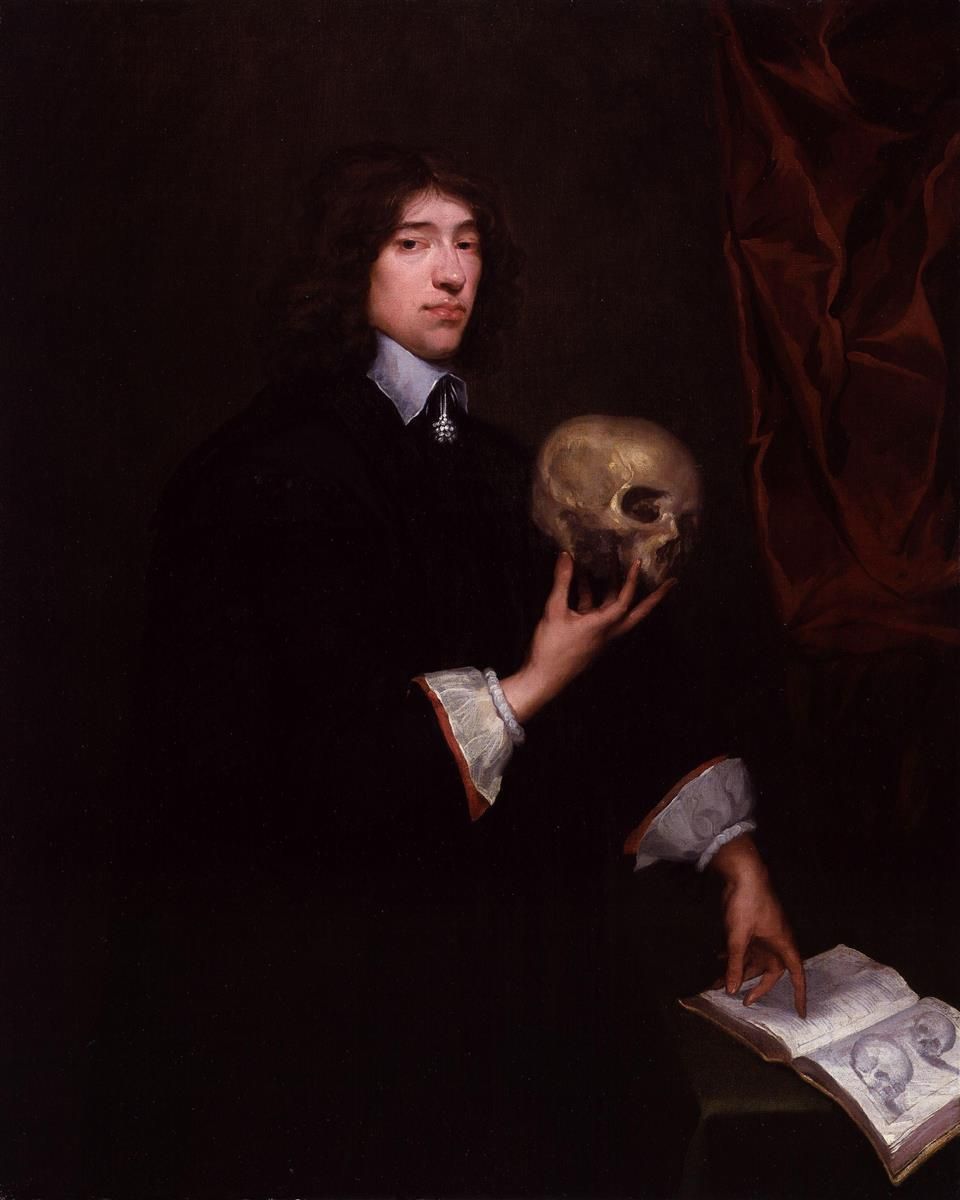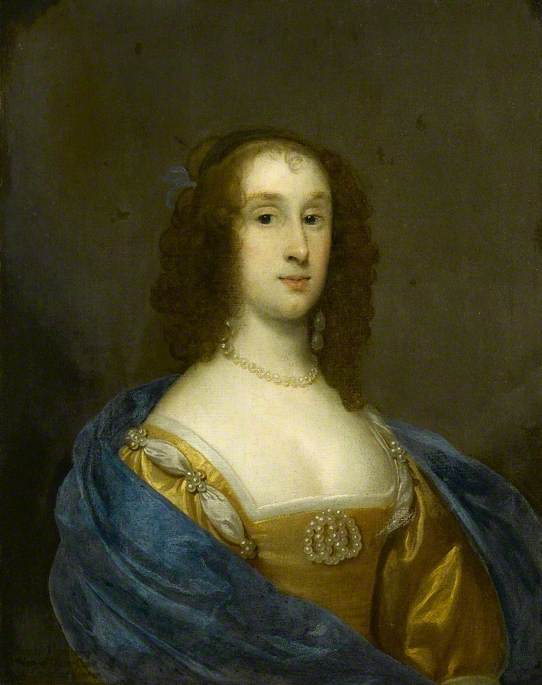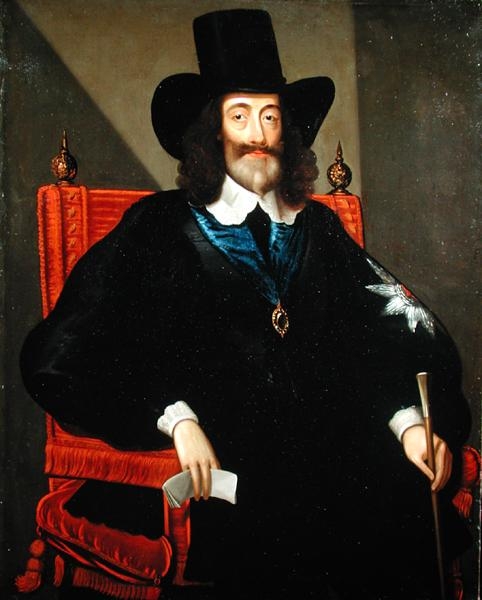|
Colonel Matthew Tomlinson
Matthew Thomlinson (1617–1681) was an English soldier who fought for Parliament in the English Civil War. He was a regicide of Charles I. Tomlinson was a colonel of horse (cavalry) in the New Model Army and was one of the officers presenting the remonstrance to parliament in 1647. He took charge of Charles I in 1648, until Charles's execution, but refused to be his judge. He followed Oliver Cromwell to Scotland in 1650. On Cromwell's dissolution of the Rump Parliament, Tomlinson was chosen as one of the members of the Council of State that succeeded it, and of the Barebones Parliament. Sent to Ireland to join the government there, he was knighted by Henry Cromwell who, nevertheless, distrusted him; in 1658 he was recalled to London as one of Ireland's representatives in Oliver Cromwell's new House of Peers. He was impeached by the parliamentary party in 1660 but escaped punishment at the restoration of the monarchy. Biography Thomlinson, baptised 24 September 1617, was the se ... [...More Info...] [...Related Items...] OR: [Wikipedia] [Google] [Baidu] |
English Civil War
The English Civil War or Great Rebellion was a series of civil wars and political machinations between Cavaliers, Royalists and Roundhead, Parliamentarians in the Kingdom of England from 1642 to 1651. Part of the wider 1639 to 1653 Wars of the Three Kingdoms, the struggle consisted of the First English Civil War and the Second English Civil War. The Anglo-Scottish war (1650–1652), Anglo-Scottish War of 1650 to 1652 is sometimes referred to as the ''Third English Civil War.'' While the conflicts in the three kingdoms of England, Kingdom of Scotland, Scotland and Kingdom of Ireland, Ireland had similarities, each had their own specific issues and objectives. The First English Civil War was fought primarily over the correct balance of power between Parliament of England, Parliament and Charles I of England, Charles I. It ended in June 1646 with Royalist defeat and the king in custody. However, victory exposed Parliamentarian divisions over the nature of the political settlemen ... [...More Info...] [...Related Items...] OR: [Wikipedia] [Google] [Baidu] |
Francis Hacker
Colonel Francis Hacker (died 19 October 1660) was an English soldier who fought for Parliament during the English Civil War and one of the regicides of King Charles I of England. Biography Francis Hacker was baptised on 16 March 1605 at All Hallows, Gedling, Nottinghamshire, the third son of Francis Hacker of East Bridgford and Colston Bassett, Nottinghamshire, and Anne. They had about thirteen children. Anne died in 1616 and is buried at St Mary the Virgin, Lowdham, Nottinghamshire. Francis's second wife was Margaret, daughter of Walter Whalley of Cotgrave. She had first married George Rossell of Radcliffe-on-Trent with whom she had three children. The portrait featured is a newly discovered painting of Francis Hacker which is now on display at the National Civil War Centre, Newark, Nottinghamshire. From the outbreak of the English Civil War Hacker, vehemently supported the Parliamentary cause, though the rest of his family seem to have been Royalists. On 10 July 1644 he ... [...More Info...] [...Related Items...] OR: [Wikipedia] [Google] [Baidu] |
Commonwealth (England)
The Commonwealth of England was the political structure during the period from 1649 to 1660 when England and Wales, later along with Ireland and Scotland, were governed as a republic after the end of the Second English Civil War and the trial and execution of Charles I. The republic's existence was declared through "An Act declaring England to be a Commonwealth", adopted by the Rump Parliament on 19 May 1649. Power in the early Commonwealth was vested primarily in the Parliament and a Council of State. During the period, fighting continued, particularly in Ireland and Scotland, between the parliamentary forces and those opposed to them, in the Cromwellian conquest of Ireland and the Anglo-Scottish war of 1650–1652. In 1653, after dissolution of the Rump Parliament, the Army Council adopted the Instrument of Government, by which Oliver Cromwell was made Lord Protector of a united "Commonwealth of England, Scotland and Ireland", inaugurating the period now usually kn ... [...More Info...] [...Related Items...] OR: [Wikipedia] [Google] [Baidu] |
Ampthill Park
Ampthill Park and Ampthill Park House is a country estate in Ampthill, Bedfordshire, England. The park was opened to the public after the Second World War. From the 14th century Ampthill Park was a royal lodge and hunting park. In the 15th century it was occupied by Sir John Cornwall, who had married the king's sister, Elizabeth of Lancaster, Duchess of Exeter. Sir John amassed a large fortune and constructed Ampthill Castle, a fortified house. After his death Ampthill Park passed to Edmund Grey, 1st Earl of Kent before becoming royal property again. Henry VIII used it for hunting and to hold Katherine of Aragon during the annulment of their marriage. By 1600 the castle was ruinous. Plans made in 1605 to rebuild the palace with parallel lodgings for James VI and I and Anne of Denmark were abandoned. The architect John Thorpe was involved in the project. In 1661 the park was given by Charles II to John Ashburnham, a Royalist supporter. The present house was built from 1687 ... [...More Info...] [...Related Items...] OR: [Wikipedia] [Google] [Baidu] |
Henry Seymour (Langley)
Henry Seymour of Langley (1612 – 9 March 1686), was an English courtier who supported the Royalist cause in the English Civil War and after the Restoration sat in the House of Commons from 1660 to 1681. Biography Seymour was the second son of Sir Edward Seymour, and Dorothy, daughter of Sir Henry Killigrew of Lothbury, Cornwall. He was a Page of Honour to Queen Henrietta Maria and made Groom of the Bedchamber to Charles, Prince of Wales in 1638. Upon the outbreak of the English Civil War Seymour joined the Royalist army, serving under his kinsman William, Marquess of Hertford. He accompanied the Marquess into Somerset and was at Battle of Sherburn when with only two troops of horse (cavalry) and 400-foot, the Royalists withstood the whole force of the William, Earl of Bedford, consisting of above 7,000-foot supported by horse and artillery. During this engagement Hertford sent Bedford a challenge which was carried by Seymour. Attaching himself to Prince Charles, he carri ... [...More Info...] [...Related Items...] OR: [Wikipedia] [Google] [Baidu] |
Restoration (1660)
The Stuart Restoration was the reinstatement in May 1660 of the Stuart monarchy in England, Scotland, and Ireland. It replaced the Commonwealth of England, established in January 1649 after the execution of Charles I, with his son Charles II. The Commonwealth of England had been governed by Lord Protector Oliver Cromwell and then his son Richard Cromwell. The term is also used to describe the reign of Charles II (1660–1685), and sometimes that of his younger brother James II (1685–1688). The Protectorate After Richard Cromwell, Lord Protector from 1658 to 1659, ceded power to the Rump Parliament, Charles Fleetwood and John Lambert then dominated government for a year. On 20 October 1659, George Monck, the governor of Scotland under the Cromwells, marched south with his army from Scotland to oppose Fleetwood and Lambert. Lambert's army began to desert him, and he returned to London almost alone whilst Monck marched to London unopposed. The Presb ... [...More Info...] [...Related Items...] OR: [Wikipedia] [Google] [Baidu] |
Lord Deputy Of Ireland
The Lord Deputy was the representative of the monarch and head of the Irish executive (government), executive under English rule, during the Lordship of Ireland and then the Kingdom of Ireland. He deputised prior to 1523 for the Viceroy of Ireland. The plural form is ''Lords Deputy''. List of Lords Deputy Lordship of Ireland Kingdom of Ireland The title subsequently became Lord Lieutenant of Ireland, with the holder also known informally as the Viceroy. References Citations Bibliography * Further reading * Lordship of Ireland Heads of state of Ireland Early modern history of Ireland Long stubs with short prose {{Ireland-hist-stub ... [...More Info...] [...Related Items...] OR: [Wikipedia] [Google] [Baidu] |
William Petty
Sir William Petty (26 May 1623 – 16 December 1687) was an English economist, physician, scientist and philosopher. He first became prominent serving Oliver Cromwell and the Commonwealth of England, Commonwealth in Cromwellian conquest of Ireland, Ireland. He developed efficient methods to survey the land that was to be confiscated and given to Cromwell's soldiers. He also remained a significant figure under Charles II of England, King Charles II and James II of England, King James II, as did many others who had served Cromwell. Petty was also a scientist, inventor, and merchant, a charter member of the Royal Society, and briefly a member of the Parliament of England. However, he is best remembered for his theories on economics and his methods of ''political arithmetic''. He was knighted in 1661. Life Early life Petty was born in London, where his father and grandfather were Cloth merchant, clothiers. He was a precocious and intelligent youth and in 1637 became a cabin ... [...More Info...] [...Related Items...] OR: [Wikipedia] [Google] [Baidu] |
Charles Fleetwood
Charles Fleetwood ( 1618 – 4 October 1692) was an English lawyer from Northamptonshire, who served with the Parliamentarian army during the Wars of the Three Kingdoms. A close associate of Oliver Cromwell, to whom he was related by marriage, Fleetwood held a number of senior political and administrative posts under the Commonwealth, including Lord Deputy of Ireland from 1652 to 1655. After Cromwell's death in September 1658, Fleetwood initially supported his son Richard Cromwell as Lord Protector, before forcing him from power in April 1659. Together with John Lambert, he dominated government for a little over a year before being outmaneuvered by George Monck. Following the Stuart Restoration, Fleetwood was excluded from the Act of Indemnity of 1660, but escaped prosecution since he had not been involved in the Execution of Charles I in January 1649. Instead, he was barred from public office, and lived quietly in Stoke Newington, where he died on 4 October 1692. Early ... [...More Info...] [...Related Items...] OR: [Wikipedia] [Google] [Baidu] |
The Protectorate
The Protectorate, officially the Commonwealth of England, Scotland and Ireland, was the English form of government lasting from 16 December 1653 to 25 May 1659, under which the kingdoms of Kingdom of England, England, Kingdom of Scotland, Scotland, and Kingdom of Ireland, Ireland, with their associated territories were joined together in the Commonwealth of England, governed by a Lord Protector. It began when Barebone's Parliament was dissolved, and the Instrument of Government appointed Oliver Cromwell as Lord Protector of the Commonwealth. Cromwell died in September 1658 and was succeeded by his son Richard Cromwell. Richard resigned in May 1659 due to his inability to control either the Army or Parliament of England, Parliament. He was replaced by the English Committee of Safety, which dissolved the Third Protectorate Parliament, and reseated the Rump Parliament dismissed by his father in April 1653. This marked the end of the Protectorate, with the Rump acting as the legisl ... [...More Info...] [...Related Items...] OR: [Wikipedia] [Google] [Baidu] |
Council Of Officers
The Army Council was a body established in 1647 to represent the views of all levels of the New Model Army. It originally consisted of senior commanders, like Sir Thomas Fairfax, and representatives elected by their regiments, known as Agitators. Following the Putney Debates of October to November 1647, Fairfax, Oliver Cromwell and Henry Ireton grew concerned by their radicalism, and in 1648, Agitators were removed from the Council. Now dominated by the so-called Grandees, it became the Council of Officers. Background When the First English Civil War began in 1642, the vast majority on both sides believed a 'well-ordered' monarchy was divinely mandated. They disagreed on what 'well-ordered' meant, and who held ultimate authority in clerical affairs. Royalists generally supported a Church of England governed by bishops, appointed by, and answerable to, the king; Puritans believed he was answerable to the leaders of the church, appointed by their congregations. However, 'Purit ... [...More Info...] [...Related Items...] OR: [Wikipedia] [Google] [Baidu] |
Council Of State (England)
A council of state is a governmental body in a country, or a subdivision of a country, with a function that varies by jurisdiction. It may be the formal name for the Cabinet (government), cabinet or it may refer to a non-executive advisory body associated with a head of state. In some countries it functions as a Administrative court, supreme administrative court and is sometimes regarded as the equivalent of a privy council. Modern * Council of State (Belgium), Belgian Council of State is a judicial and advisory body that assists the executive with obligatory legal advice on each draft law and is the supreme court for administrative justice * State Council of the People's Republic of China, Chinese State Council is the country's highest executive body * Council of State of Colombia, Colombian Council of State * Cuban Council of State * Danish Council of State is similar to a privy council with a largely ceremonial role * Dutch Council of State is an advisory body that consists of ... [...More Info...] [...Related Items...] OR: [Wikipedia] [Google] [Baidu] |







